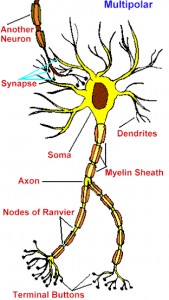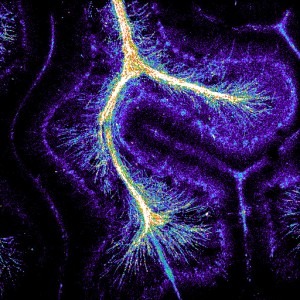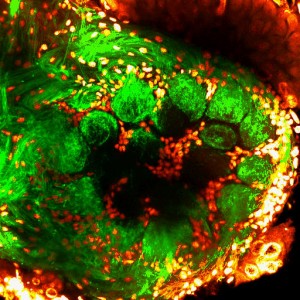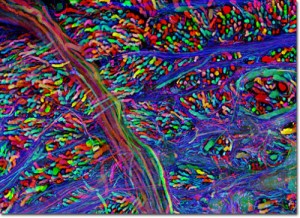Last week I ran across a list: “The 100 Most Beautiful Words in English.” I think the words were chosen more for their sound and feeling, as opposed their meaning.
The list included:
Chatoyant – like a cat’s eye
Efflorescence – flowering, blooming
Evanescent – vanishing quickly
Lagniappe – a special kind of gift
Mellifluous – sweet sounding
Scintilla – a spark or very small thing
Woebegone – sorrowful
A word that I had never heard of but loved: Petrichor – The smell of earth after rain.
I would have added: Panache – a sense of spirited style and self-confidence; and Pulchritude – physical comeliness. Because I would like to have both!
Prior to reading this list, I had been reading about cell division. Together, they prompted me think about words used to name the physical structures of the human body. Consequently, here is my list:
Top 50 Beautiful Words of Human Anatomy
1. Mitochondria – the power plant of cells that produces energy.
2. Ribosome – part of the cell that produces amino acids and RNA.
3. Golgi Apparatus – Complex in the cytoplasm of cells involved intracellular transport.
4. Cisternae – Cup-shaped membrane-covered sacs.
5. Flagellum – hairlike structures that provide movement for some cells.
6. Cilia – hairlike projections that sweep away fluids and particles.
7. Meninges – covering for the brain.
8. Dura mater – “Tough mother” – protective leather-like layer over the brain.
9. Pia mater – “Soft mother – inner most layer of the meninges that adheres to the brain like a delicate sheet of Saran wrap.
10. Foramina – holes in the skull through which cranial nerves, veins, arteries, and other structures pass.
11. Circle of Willis – arterial complex at the base of the brain.
12. Amygdala – almond-shaped mass of nuceli in the temporal lobe of the brain involved in processing of emotions and motivations related to survival.
13. Alveoli – tiny air sacs in the lungs.
14. Fovea – center of the retina responsible for the eye’s sharpest vision.
15. Vitreous Body – clear gel-like substance that fills the eyeball behind the lens.
16. Obicularis oculi – muscle that surrounds the eye.
17. Papillae – mushroom-shaped or nipple-shaped structures.
18. Fungiform – papillae on the tongue responsible for sweet and sour taste.
19. Gingival sulcus – space between the gums and teeth.
20. Islets of Langerhans – region of the pancreas that produces insulin.
21. Ampulla of Vater – joins the bile duct and the pancreatic duct.
22. Sphincter of Oddi – muscular valve that controls the flow of digestive juices into the duodenum (first part of the small intestine).
23. Loop of Henle – portion of a nephron (kidney cell) that transports urine.
24. Bowman’s capsule – portion of a nephron that filters wastes.
25. Melanocytes – cells that produce a skin’s color.
26. Sebaceous gland – skin cell group that produces an oily/waxy substance.
27. Sudoriferous gland – skin cell group that produces sweat.
28. Meissner’s corpsucle – star-shaped cells in the skin responsible for light touch.
29. Lamella corpuscles and Pacinian corpuscles – nerve endings in the skin responsible for sensitivity to vibration and pressure.
30. Merkel cells – mechanoreceptors in the skin responsible for determining shape and texture.
31. Incus, malleus, and stapes – smallest bones of the body located in the middle ear.
32. Eustacian tube –links the pharynx to the middle ear
33. Lacrimal gland – cell group that produces tears.
34. Erythrocytes – red blood cells that carry oxygen to the body.
35. Leukocytes – white blood cells that protect the body against disease-causing microorganisms.
36. Phagocytes – scavenger cells that ingest foreign particles—like bacteria, carbon, and dust.
37. Platysma – Ladies: when you feel bad about your neck like Nora Ephron, this is the muscle that affects that area. It atrophies with age: makes the skin pucker and draws the corners of the mouth down.
38. Buccinator – cheek muscle.
39. Zygomatic bone – cheek bone.
40. Acetabulum – concave surface of the pelvis – where the head of the thigh bone meets the hip bone.
41. Femur – thigh bone = strongest bone in the body—stronger than cement.
42. Hallux – big toe.
43. Calcaneus – heel bone.
44. Vagus nerve – largest cranial nerve of the body.
45. Uvula – dangly thing in the back of the throat responsible for the gag reflex and closing off the nasopharynx so food and liquids don’t go up tour nose.
46. Epiglottis – flap of cartilage at the base of the tongue that covers the trachea when swallowing so food and liquid don’t get into the windpipe and lungs.
47. Thymus – an organ in the chest between the heart and breast bone responsible for producing T-cells (lymphocytes) needed for immune function.
48. Superior Vena Cava – cardiac vein.
The following are my two favorite parts of the body.
49. Ischial tuberosity – Attention computer users, couch potatoes, fence sitters, and cubicle dwellers: This is a bony swelling on the posterior part of the superior ramus of the ischium (pelvis area) that gives attachment to various muscles and bears the weight of the body in a sitting position. AKA the “sitz bone.”
50. Neuron – cell of the central nervous system that transmits information through electrical and chemical signaling.
No neurons = no thinking = brain dead.

The parts of the neuron are the coolest in human anatomy:
Purkinje cells – large neuron in the cerebellum responsible for controlling motor movement.
Axon – part of the neuron that conducts electrical impulses.
Schwann cells – support cells on the axon.
Dendrites – projections at the ends of neurons that receive information and form synaptic contact with other neurons’ terminals.
Myelin sheath – insulating layer around neurons made up of fatty substances that allows rapid and efficient transmission of impulses. Allows the impulse to slide along the axon.
Bouton – button-like swelling on an axon that has a synapse with another neuron.
Glia – cells that provide support and protection for neurons.
AND – my all-time FAVORITE body part:
Nodes of Ranvier – periodic gap in the insulating myelin sheath on the axon of certain neurons. These allow electrical impulses to skip along the axon—even faster than sliding—which provides quicker processing of information.
Better nodes = better noggin!
When you see how amazing human anatomy is, doesn’t it make you want to take better care of your body?
P.S. Award for the Prettiest Cells: Glia




100 Words List:
http://lapresmidiprelude.wordpress.com/2011/06/13/the-100-most-beautiful-words-in-english/

My last vacation was on the Islet of Langerhans. I got looped with Henle whhile watching ‘American Idol”. Did Pia mater ????? I tried to use my Golgi apparatus to change the channel but my Cisternae got in the way. Then, I hit my Hallux on the Buccinator. Great Words !!! take care of the body and mind so that you don’t develope amyloid plaque in your brain which is associated with Alzheimer’s Disease. Your neurons will be glad that you did. Laminin is another miraculous word. It is a protein in the shape of a CROSS that holds your body together by adhering to other molecules.
Nice post, with great words. One of my favorite anatomical words is Hyoid, the name of the only bone in the throat, and the only bone in the body that is not linked to any other bone. Without this lovely horseshoe-shaped bone, speaking would be difficult, maybe impossible.
Great selection! I did not know about this bone. Must have been snoozing in class that day.
Miss Stipova —
Another cool anatomical word I’ve never heard of. I can see where the word “laminate” comes from.
Your vacation story killed me! Which is why DiDi is such a good name for you. 😉